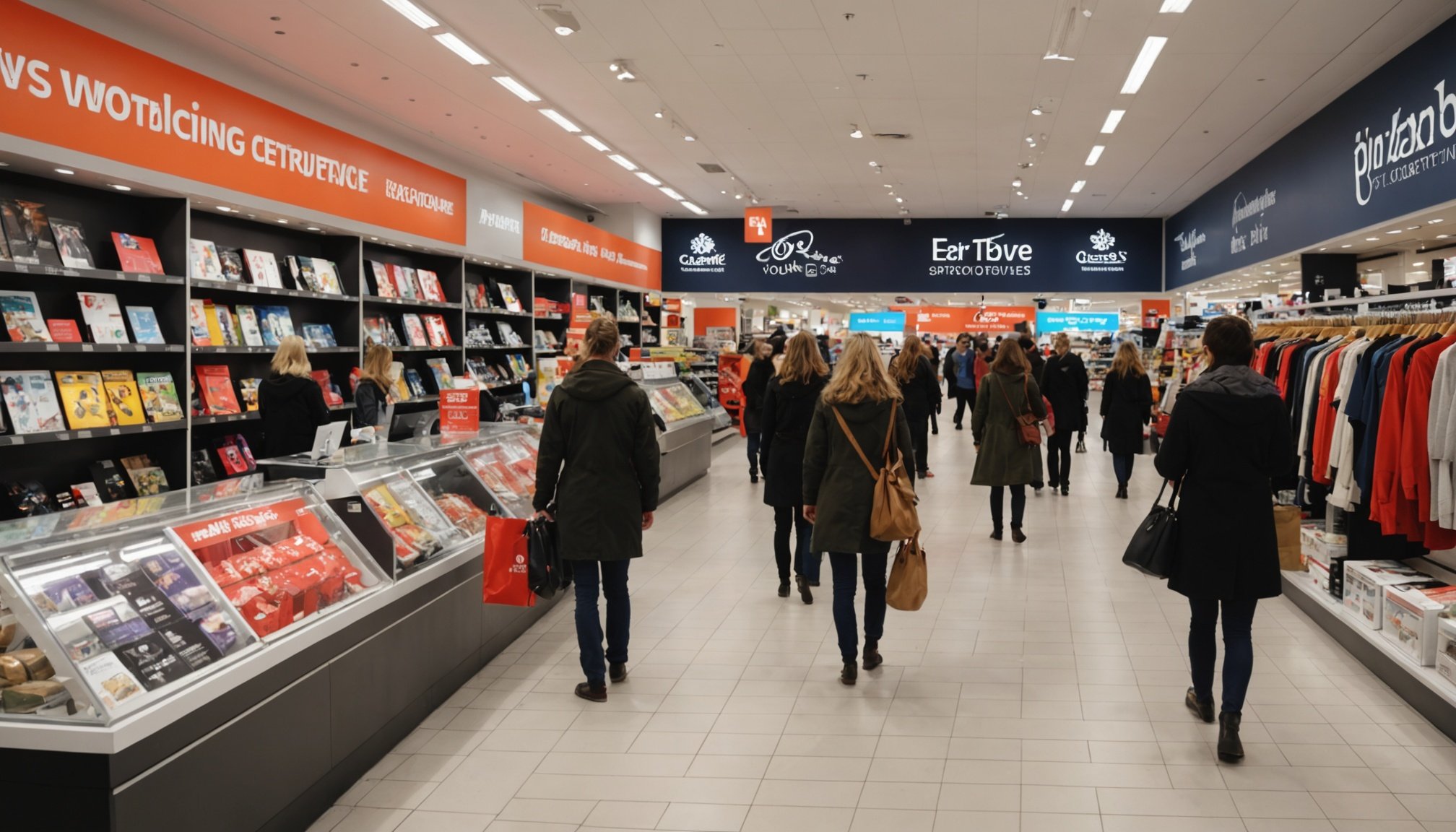Overview of In-Store Experience Enhancement
In the UK retail landscape, prioritizing the in-store experience is crucial for boosting customer satisfaction. As trends shift, understanding evolving consumer behavior becomes pivotal. Modern consumers increasingly seek personalized and immersive experiences, making the physical retail environment an important differentiator. When executed effectively, a positive in-store experience not only attracts new customers but also cultivates loyalty among existing ones, enhancing overall sales.
Current trends demonstrate a greater emphasis on creating memorable visitations by retailers. This involves integrating seamless interactions and personalized services that reflect customer predispositions. Hence, the physical ambiance, store layout, and customer service quality become increasingly significant. When these elements align with customer expectations, they contribute to long-term loyalty.
Topic to read : Discover the advantages of joining a business networking group in the uk
Furthermore, understanding local demographics and preferences allows retailers to tailor their in-store strategies effectively. This understanding can guide merchandising decisions and store environment enhancements, ensuring a resonance with target audiences. Ultimately, a well-crafted in-store experience becomes a catalyst not just for immediate purchases but for enduring customer relationships within the dynamic UK market. As retailers adapt, they align their offerings with the consumer’s heightened expectations for engagement and authenticity.
Understanding Customer Needs and Preferences
To build a successful retail strategy, grasping customer preferences is vital. This involves leveraging shopper insights to tailor offerings. One effective technique is gathering feedback through surveys, feedback forms, and digital channels. These tools help UK retailers register opinions on products, services, and overall experiences. Understanding local demographics also enriches this data, enabling specific merchandising that resonates with regional preferences.
Also to see : Maximizing success: strategies for uk companies to thrive in global partnerships
Analyzing customer behaviour data can significantly enhance decision-making. Tracking shopping patterns, purchase frequencies, and customer feedback reveals trends. For instance, insight into peak shopping hours allows stores to adjust staffing efficiently, thus enhancing customer satisfaction.
UK retailers often implement focus groups to dive deeper into shopper expectations. These groups provide qualitative data, offering nuanced insights beyond numerical analysis. They reveal preferences regarding in-store layouts, product offerings, and promotional strategies. The engagement here is about more than information gathering—it’s about building relationships and showing responsiveness.
In a dynamic UK retail landscape, these analytical strategies ensure retailers remain agile. By understanding customer needs and preferences, businesses can precisely tune their offerings, fostering a retail space that feels personal and responsive to the shopper’s desires.
Enhancing Store Layout and Design
In the competitive world of UK retail, a well-thought-out store layout is vital for creating an inviting atmosphere. An optimized layout enhances flow, allowing customers to navigate easily and discover products more intuitively. This builds a seamless shopping experience, driving not only impulse purchases but also encouraging repeat visits.
Visual merchandising plays a crucial role in captivating customers’ attention. Strategic product placement, attractive displays, and thought-provoking signage contribute to an engaging design that resonates with the shopper and reinforces brand identity. By highlighting specific items or themes, merchandising can guide customers through the shopping journey, boosting engagement.
Case studies from notable UK stores reveal successful redesigns that focus on these principles. For instance, retailers adopting open-floor concepts with carefully curated zones saw increased shopper dwell time and improved sales. By prioritizing adaptable and dynamic layouts, retailers can swiftly respond to changing trends and consumer demands, maintaining relevance in an ever-evolving market.
The integration of an engaging design fosters a positive shopping environment where individuals feel welcome and appreciated. By elevating store layout and design, retailers not only cater to consumer expectations but also enhance the overall in-store experience.
Leveraging Technology for Enhanced Experience
In the evolving retail technology landscape, incorporating innovative digital tools is pivotal for enhancing customer engagement. These advancements allow retailers to meet elevated consumer expectations efficiently. Current technology trends embrace mobile apps and augmented reality (AR) to enrich the shopping journey. Mobile apps provide customers with personalized recommendations, fostering a more interactive experience. They often integrate seamlessly with online platforms, ensuring a consistent brand interaction across channels.
Augmented reality, meanwhile, expands the physical store’s potential by providing virtual product visualizations. This not only entertains but also educates, allowing customers to make informed purchasing decisions without leaving the store premises. Moreover, employing omnichannel strategies effectively merges the online and offline worlds, offering customers a cohesive shopping experience.
Omnichannel retailing ensures that customer data from online behaviors inform in-store interactions, tailoring experiences and promotions to the multidimensional shopper. This integration encourages loyalty and increases sales by meeting diverse customer needs and preferences, thus maximizing the impact of technology in UK’s dynamic retail environment. Adopting these technologies positions retailers to captivate consumers and foster enduring relationships.
Employee Engagement and Training
In the UK retail landscape, the role of employee engagement cannot be overstated. Enthusiastic and knowledgeable staff are pivotal in delivering exceptional customer service and enriching the in-store experience. Effective employee training programs empower staff, providing them with the skills needed to cater to diverse customer needs and preferences. By focusing on areas such as communication, product knowledge, and engagement strategies, these programs transform employees into brand ambassadors who inspire customer satisfaction.
Training should be ongoing, adapting to emerging retail trends and technologies. For instance, workshops that enable staff to use digital tools like mobile apps enhance interactions. Moreover, training in personalized service approaches ensures employees can tailor their assistance, fostering meaningful customer interaction.
Recognizing and rewarding exceptional service further boosts morale and motivation. Recognitions can be applied through appreciative shout-outs, incentive programs, or formal awards. These initiatives foster a sense of belonging and dedication among employees, reinforcing a positive work environment.
Investing in staff engagement and training not only enhances customer service but also cultivates a workplace where employees feel valued and motivated, ultimately leading to sustained retail success.
Creating a Unique Ambiance
In the UK retail landscape, store ambiance plays a pivotal role in crafting an unforgettable customer experience. This encompasses elements such as lighting, music, and scent, which collectively nurture a welcoming environment. Correct lighting can guide the customer journey, enhancing product visibility and setting the right mood. Similarly, background music tailored to a store’s brand can elevate shopping pleasure and potentially increase dwell time.
Utilising sensory marketing strategically impacts shopping behaviours. This type of marketing taps into the customer’s senses, subtly influencing emotions and purchasing decisions. For instance, a fresh scent in a clothing store can evoke cleanliness and freshness, significantly impacting customer mood and inclination to buy.
Case studies from UK retailers illustrate the power of ambiance. Stores that have incorporated bespoke lighting and carefully curated music have seen increases in sales and customer satisfaction. A soft, inviting scent can transform a mere shopping trip into an enjoyable experience. The synergy of these elements ensures a unique ambiance, distinguishing a retailer from competitors while fostering customer loyalty.
Encouraging Customer Interaction and Experience
Building meaningful customer interaction is a cornerstone of success in the UK retail landscape. Hosting engaging events and activities—such as in-store demonstrations or workshops—not only draws customers in but also fosters a sense of community. These events offer a platform for customers to connect not just with products, but with the brand ethos itself.
Personalized experiences take customer engagement a step further. Retailers can employ these strategies to convey a deeper understanding of each customer’s unique needs and preferences. Tailored promotions or exclusive previews serve as effective tools in creating memorable shopping experiences that resonate.
To consolidate relationships, focus on strategies that emphasize community building. This might involve leveraging social media platforms to engage with customers directly or creating loyalty programs that reward interaction and participation. Brand communities enhance customer satisfaction by nurturing affiliation with the brand, thus encouraging repeat visits and purchases.
Ultimately, a focus on personalized engagement and community building bolsters the physical shopping experience. Retailers that successfully integrate these elements can cultivate a loyal customer base, enhancing their position in the competitive market.
Measuring Success and Iteration
In the UK retail landscape, accurately assessing the success of in-store experiences relies on well-chosen performance metrics. These indicators provide valuable insights into the effectiveness of strategies tailored to improve customer satisfaction. Vital metrics may include foot traffic, average transaction value, and customer retention rates. These metrics help retailers evaluate which aspects of the in-store experience are thriving and identify areas requiring enhancement.
Collecting and analyzing customer feedback is pivotal following strategy implementation. Feedback surveys, comment cards, and digital channels are effective in capturing consumer opinions. This information allows retailers to understand what resonated with their audience and discern unmet needs. Analyzing this feedback not only offers immediate corrections but also fuels long-term strategic planning.
Continuous improvement hinges on developing robust iteration strategies. This involves regularly revisiting and refining in-store approaches based on gathered insights. Adaptability ensures that retailers remain responsive to shifting consumer behaviours. By prioritising ongoing evaluation and adjustment, UK retailers can sustain and build upon customer satisfaction, securing their competitive edge in a dynamic market.


